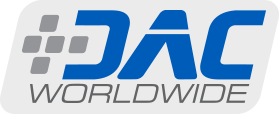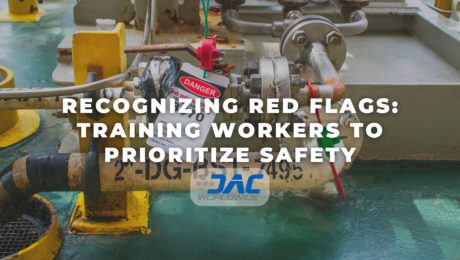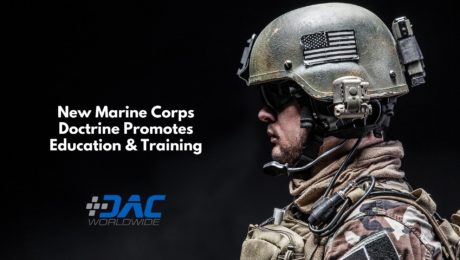Recognizing Red Flags: Training Workers to Prioritize Safety
Do you keep an eye out for red flags? If you’re still looking for that someone special, you might see red flags when their online dating profile indicates they’re unemployed and still living in their parents’ basement.
But those aren’t the red flags we’re talking about in this article. Red flags signify danger. They’re warning signs, and today’s workers need to recognize them in the workplace. Why? Their safety and wellbeing depends upon it.
Workplace safety remains a critical component of any industry’s success, yet it too frequently doesn’t get the attention it deserves. New technologies and the latest and greatest advances tend to capture the most attention, but the basics of safety can bring everything to a grinding halt if they’re ignored.
In this article, we’ll take a look at five red flags that workers must learn to recognize in order to make safety a top priority. We’ll also explain the importance of safety training and how the training tools offered by DAC Worldwide can help workers learn the skills that will keep them safe in the modern workplace.
5 Safety Red Flags Employees Must Learn to Recognize
How important is worker safety in your workplace? According to an IndustryWeek article by Matt Thiel and Dan Idzikowski, “nearly all [manufacturers] will say [safety is] a top priority…At the same time, the features and processes intended to keep people safe are rarely put to the test until a crisis occurs. It’s only when safety fails — when there is an injury or a near-miss — that companies question whether they are doing enough to protect workers.”
Modern industrial workplaces feature a wide variety of safety features designed to keep workers safe. Yet, workplace injuries remain a serious problem. For example, “more than 420,000 manufacturing workers were injured on the job in 2019, according to the U.S. Bureau of Labor Statistics, accounting for 15% of all nonfatal injuries in the private sector that year.”
What can be done to improve workplace safety? According to Thiel and Idzikowski, “[s]afety planning starts by imagining the unimaginable…it’s critical to play devil’s advocate and ask what could happen that shouldn’t, and how both the equipment and the operator will respond if it does.”
Once safety risks are identified, workers must be trained to recognize situations in which particular care must be taken to avoid injury. Otherwise, “[w]hen safety is treated as an afterthought, it’s only a matter of time until a preventable accident happens.” Here are five specific red flags Thiel and Idzikowski belive workers must learn to recognize:
- Access: Workers must learn to recognize situations in which “[o]perators can access hazardous areas while the hazard is present. Systems that require hands-on operator involvement…have built-in risks…Making these systems safe may mean containing the hazard behind guards or designing the machine so it won’t run until the operator is clear. Whether the danger is readily apparent, like moving parts, or invisible, like electrical current, the best safeguards make it impossible for the operator to even get near.”
- Rules: Workers should be on high alert for situations in which “[p]eople are bypassing the rules.Safety depends on people choosing to follow the rules…Even well-trained people can be lulled into a false sense of security and start taking shortcuts to make work faster or easier…If people are looking for ways around a safety system, it’s probably not well aligned with the operation. Rather than disabling the mechanism or retraining the operators, analyze the entire system and find a way to marry safety with the way the process really works.”
- Alarms: Workers need to notify management when “[a]larm systems don’t distinguish between emergencies and non-emergencies…if the system treats everything like an emergency, workers will treat nothing like an emergency. Frequent false alarms will lead workers to ignore the warning signs or circumvent them.”
- Obsolete: Workers must learn to keep an eye out for “[s]afety features [that] are outdated.A test of older fail-safes may find they no longer work — if they ever did in the first place…Maintaining a safe work environment means ongoing risk assessment. Safety professionals should perform regular audits of the equipment on the shop floor and keep an eye out for advancements that could make it safer.”
- Routine: Workers should alert management when they notice that “[s]afety features are not regularly tested and validated…the systems that keep workers safe should be checked on a regular basis.”
If workers can learn to recognize these five red flags, safety will become a higher priority and everyone in the workplace will benefit. As Thiel and Idzikowski acknowledge, “[t]he return on investment in safety is hard to measure. If a company invests millions in safety upgrades and there are no near-misses, was it a waste of money or did the upgrades do their job? A better question is what might realistically happen without safety upgrades.”
Safety Training: Begin with the Basics
Basic safety procedures are essential to keeping employees from becoming injured on the job. While manufacturing jobs can be dangerous, instituting safety procedures and ensuring that employees are properly trained are critical steps that employers must take to minimize the risk of injuries or death.
Not only does proper safety training reduce the number of workplace injuries, but it also adds to a company’s bottom line by improving productivity and reducing downtime caused by employees who can’t work when injured. But where should an employer start? How about at the beginning?
One of the most basic—and important—areas to focus on is the control of hazardous energy, often known by its more popular moniker “lockout/tagout.” According to the United States Department of Labor’s Occupational Safety and Health Administration (OSHA), “[e]nergy sources including electrical, mechanical, hydraulic, pneumatic, chemical, thermal, or other sources in machines and equipment can be hazardous to workers. During the servicing and maintenance of machines and equipment, the unexpected startup or release of stored energy can result in serious injury or death to workers.”
“Workers servicing or maintaining machines or equipment may be seriously injured or killed if hazardous energy is not properly controlled…Injuries may include electrocution, burns, crushing, cutting, lacerating, amputating, or fracturing body parts… Craft workers, electricians, machine operators, and laborers are among the millions of workers who service equipment routinely and face the greatest risk of injury.”
Fortunately, “[p]roper lockout/tagout (LOTO) practices and procedures safeguard workers from hazardous energy releases.” Teaching workers hands-on LOTO skills will help them to understand how to properly control hazardous energy and maintain a safe work environment.
DAC Worldwide Offers Superior LOTO Training
For companies looking to improve their safety training, a thorough review of current training materials is a great place to start. Do employees have access to hands-on training with actual components they’ll encounter on the job? If not, partnering with established companies to provide industrial-quality training systems that will stand the test of time will help ensure the continued safety of the workforce.
Employers don’t need to recreate the wheel to move toward a skills-based approach to hiring. DAC Worldwide, an industry-leading manufacturer of technical assessment and training tools, offers a variety of solutions to the problems employers face.
For example, DAC Worldwide offers a safety training system specifically designed to give employees the hands-on experience they need to master lockout/tagout skills. DAC Worldwide’s Lock-Out/Tag-Out Training System (811-000) features a realistic, simulated working process environment that facilitates introductory training with hands-on activities related to the process of identifying and locking out sources of dangerous potential energy in an industrial setting.
Since technical training is most effective when learners can gain hands-on practice with industry-standard components they’ll encounter on the job, the Lock-Out/Tag-Out Training System features a wide variety of common, industrial-quality components to provide learners with a realistic training experience that will build skills that translate easily to the workplace.
For example, the Lock-Out/Tag-Out Training System features:
- two PVC process tanks with removable covers, vents, drains, and process connections;
- PVC process network with block valves, 3-way valves, figure-8 blinds, and descriptive valve tags;
- fractional HP magnetic drive centrifugal pump;
- drain collection and distribution tubing network with valved central collection manifold;
- electrical controls, with provision for lock-out, including primary service disconnect, motor starter switch, in-line GFI protector, and system plug connection; and
- a comprehensive lock-out/tag-out tool kit with color-coded locks, tags, multi-lock hasps, specialty electrical locking devices, valve locking devices of multiple designs, and a dedicated toolbox.
The Lock-Out/Tag-Out Training System’s courseware consists of a training manual and hands-on exercises. These can be used as part of either an instructor-led course or self-directed study. A final performance assessment exercise is also provided, allowing the system to be used in an alternate configuration for testing purposes.
Contact a consultant with DAC Worldwide today to learn more about how their technical training tools can help you build the assessment and training program your company needs. Using DAC Worldwide training and assessment tools, you can transition to a skills-based hiring approach and fill the skills gaps in your organization!
- Published in News
New Marine Corps Doctrine Promotes Education & Training
Click here to view New Marine Corps Doctrine Promotes Education & Training as a multimedia presentation.
The few. The proud. Who are we talking about? The Marines, of course. That particular recruiting slogan has been permanently etched into our memories over the years.
And it’s a great slogan. The Marines are legendary for a training regimen that weeds out all but the strongest, creating a fighting force to be reckoned with. Indeed, the Marines have been on the front lines of every major U.S. military campaign of the modern era.
To be prepared for the future, however, the Marines know that training the same way they have in the past will not be sufficient. That’s why a recent doctrinal publication puts a new focus on education and continued learning.
Industry, always closely connected to the military, would do well to put a renewed emphasis on education and training, too. In this article, we’ll take a closer look at how partnering with a trusted technical training company like DAC Worldwide can prepare your students, workers, soldiers, and sailors for a bright future.
A New Doctrine for a New Era
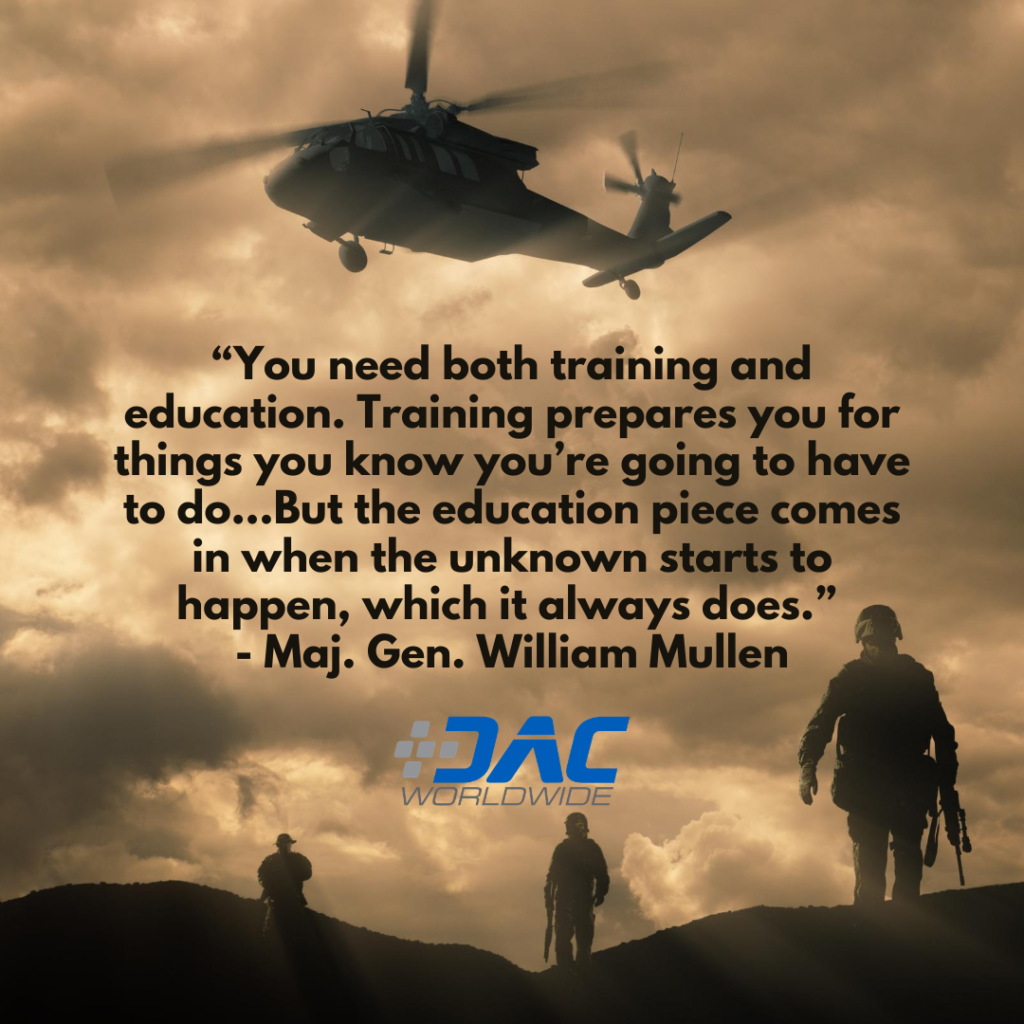 According to a Marine Corps Times article, “the Marine Corps unveiled the Marine Corps Doctrinal Publication 7 [MCDP 7] in February [2019] as the service aims to promote education, training, and continued learning among Marines so they become students of their profession.”
According to a Marine Corps Times article, “the Marine Corps unveiled the Marine Corps Doctrinal Publication 7 [MCDP 7] in February [2019] as the service aims to promote education, training, and continued learning among Marines so they become students of their profession.”
How significant was this doctrinal development? MCDP 7 was the first new doctrinal publication issued by the Marines since 2001. Its goal: “to motivate Marines to personally assess where they can improve and understand the ‘why’ behind the significance of learning.”
Maj. Gen. William Mullen was quoted as saying “that he’s heard Marines say they joined the service to escape an academic education. But the Corps wants its personnel to understand that the two complement one another and that education prepares Marines to think quickly when faced with challenges.”
According to Mullen, “You need both training and education. Training prepares you for things you know you’re going to have to do…But the education piece comes in when the unknown starts to happen, which it always does.” Mullen specifically referred to the fact that the environments Marines face today present challenges that are only growing more complex.
This new doctrinal change comes as “Commandant of the Marine Corps Gen. David Berger is working to remake the Corps to better compete with potential high-end adversaries…Berger wants a leaner force to conduct sea denial operations, survive in a contested maritime environment and serve as a larger Naval expeditionary force.”
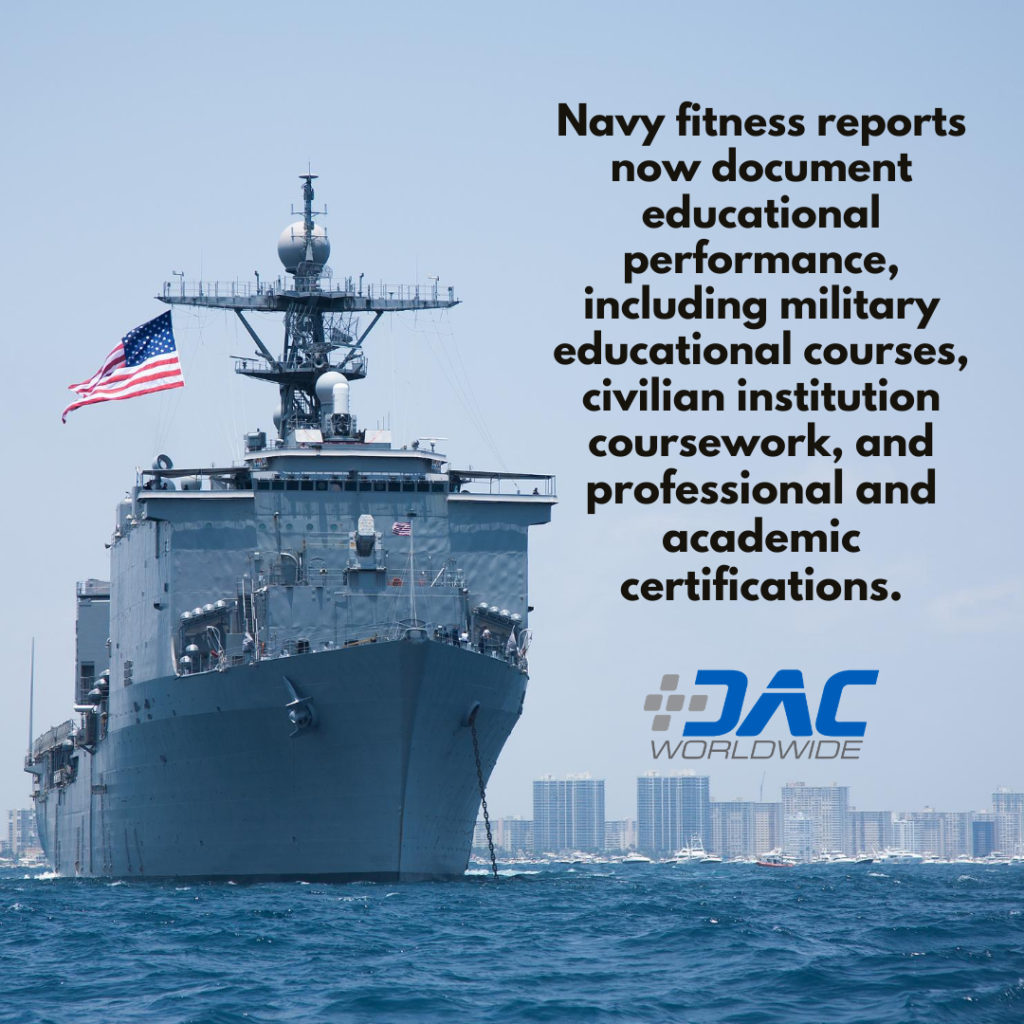 It’s Not Just the Marines
It’s Not Just the Marines
Speaking of the Navy, the Marine Corps Times article notes that the Navy announced in May 2019 “that it was modifying fitness reports to reflect an individual’s educational and training accomplishments, including military education courses, professional and academic certifications, among other things.”
Like the Marines’ new focus on education and continued learning, the Navy’s modified fitness reports are meant to “show that career-long military learning isn’t only job-related technical or tactical training, and that a commitment to higher education will produce Navy leaders with more refined critical thinking skills,” according to an article in the Navy Times.
Future Navy fitness reports will thus document educational performance, including “[m]ilitary educational courses, civilian institution coursework, and professional and academic certifications.” Navy leadership also indicated they will also encourage additional informal efforts, such as learning new technologies.
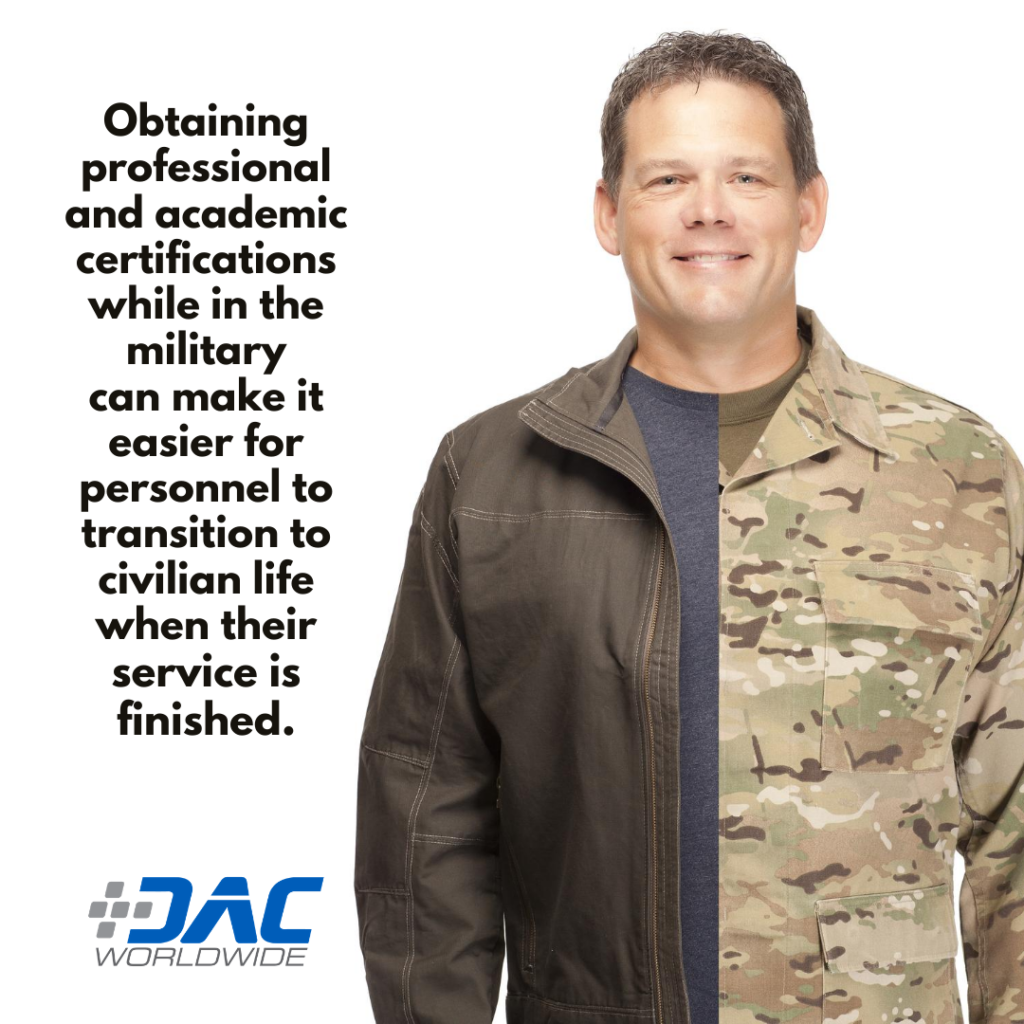 It’s All COOL
It’s All COOL
It’s no coincidence that the Marines and the Navy would emphasize professional and academic certifications. Much of the training that military personnel receive prepares them for future civilian jobs.
Obtaining professional and academic certifications while in the military can make it easier for personnel to transition to civilian life when their service is finished. All branches of the military recognize the importance of certifications in making that transition as easy as possible.
For example, the Marine Corps COOL site (Marine Corps Credentialing Opportunities On-Line) helps Marines see how their military training and experience matches up with civilian credential requirements. Such credentials could include important and valuable advanced manufacturing credentials from entities like the National Institute of Metalworking Skills (NIMS) and the Manufacturing Skill Standards Council (MSSC).
Marines using the COOL site can see whether military funding is available to help attain particular credentials. They can also see how the training and skills they’ve already acquired might match up with specific credentials valued by employers, such as NIMS’ Industrial Technology Maintenance (ITM) certification or MSSC’s Certified Production Technician (CPT) certification. There are also COOL sites for the Army, Coast Guard, Navy, and Air Force.
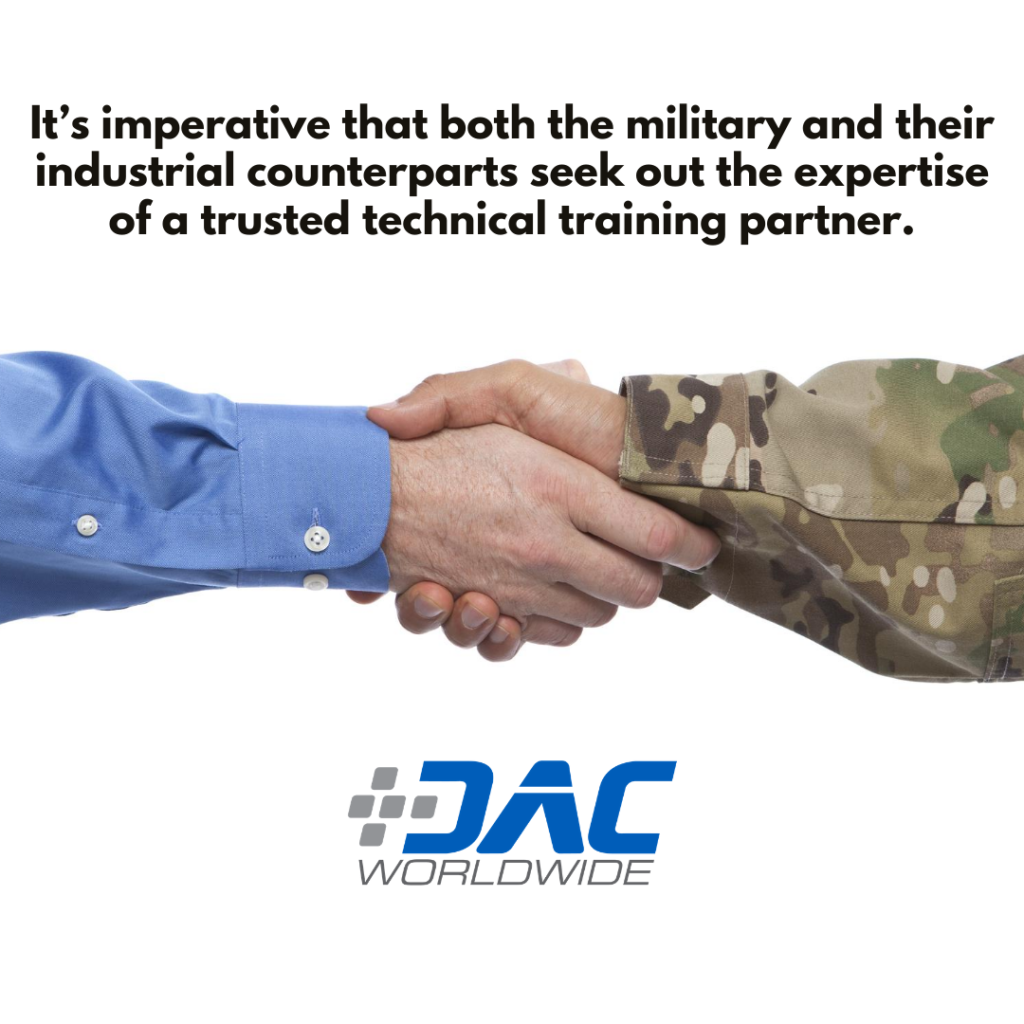 Industry Must Also Evolve
Industry Must Also Evolve
Given the military’s new focus on education and continued learning, it’s important that industries that work with and support the military evolve in a similar fashion. The military-industrial complex consists of all sorts of industries that work closely with the military to help them accomplish their mission.
These industries should take a cue from their military counterparts and begin to develop a similar focus on education and continued learning among their workforce. Industry workers will only be able to continue to keep pace with their military counterparts if they’re also seeking new educational opportunities and learning new skills and technologies.
Pushing an industrial workforce or a military organization toward more education and greater skill development can be a daunting task. That’s why it’s imperative that both the military and their industrial counterparts seek out and rely upon the expertise of a trusted technical training partner.
A Trusted Education & Training Partner
DAC Worldwide is a US-based world leader in technical training solutions. For over 35 years, DAC Worldwide has been helping industrial employers and military organizations with realistic, hands-on training systems.
DAC Worldwide offers a wide range of product solutions to fit all your training needs. From training systems that teach a full range of skills to cutaways that increase understanding of how a component works, we have what you need.
For example, many military personnel work in the same skilled occupations as civilians. This means they need a solid foundation in various technologies, including electrical, electronics, fluid power, and mechanical drives.
Whether you train military personnel working on military bases or civilian crews with military contracts, DAC Worldwide’s military training solutions offer an unmatched range of products to allow you to create the course you need or to fill in any gaps that you have in your current training.
Let’s take a closer look at four specific DAC Worldwide products that can take your training program to the next level:
Lock-Out/Tag-Out Training System (811-000)
DAC Worldwide’s Lock-Out/Tag-Out Training System features a realistic, simulated working process environment that facilitates introductory training with hands-on activities related to the process of identifying and locking out sources of dangerous potential energy in an industrial setting. The training system includes two process tanks; a centrifugal pump; a complex, multi-purpose piping network; electrical controls; a variety of lockable system components; and a lock-out/tag-out kit that features a large number of commonly-encountered locking and tagging devices.
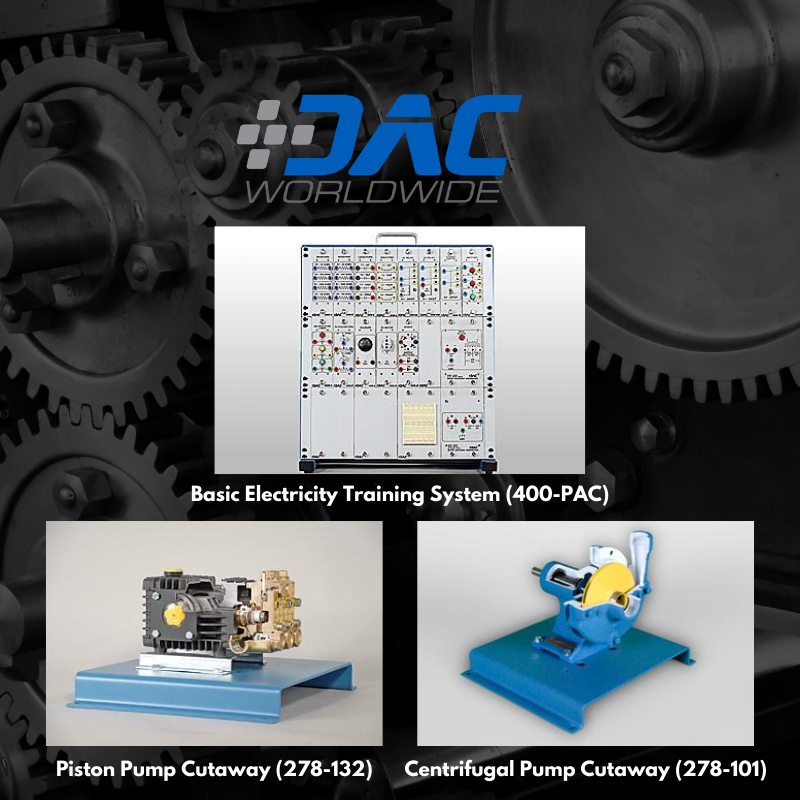 Basic Electricity Training System (400-PAC)
Basic Electricity Training System (400-PAC)
DAC Worldwide’s Basic Electricity Training System teaches basic AC and DC electrical principles. Learners will explore how electricity is used for power and control in various sectors. The trainer covers industry-relevant skills, such as installing, operating, and troubleshooting AC and DC electrical circuits in a variety of applications.
Piston Pump Cutaway (278-132)
DAC Worldwide’s Piston Pump Cutaway is an industrial piston pump that has been carefully sectioned and color-coded to train learners in the design, operation, construction, and maintenance of this common process pump used throughout industry. The cutaway exposes and showcases the complete internal configuration of an industrial piston pump. Moreover, seal features and bearings have been retained to allow realistic, hands-on pump maintenance and operation training.
Centrifugal Pump Cutaway (278-101)
DAC Worldwide’s Centrifugal Pump Cutaway is a sectioned centrifugal pump that provides realistic training in the operating principles, construction details, and maintenance of common centrifugal process pumps used throughout industry and the military. It includes various sectioned components, such as seals and bearings, as well as showcasing the pump’s impeller.
Contact DAC Worldwide Today
Is your organization ready to take its industrial technical training to the next level? Contact a DAC Worldwide expert today for a personal consultation regarding your training needs and how our variety of training systems, cutaways, dissectibles, and models can prepare both industrial workers and military personnel for the future challenges they face.

- Published in News

